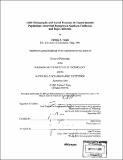Adult demography and larval processes in coastal benthic populations : intertidal barnacles in Southern California and Baja California
Author(s)
Tapia, Fabián
DownloadFull printable version (14.33Mb)
Other Contributors
Woods Hole Oceanographic Institution.
Advisor
Jesús Pineda.
Terms of use
Metadata
Show full item recordAbstract
The geographic distribution and dynamics of coastal benthic populations are shaped by physical - biological interactions affecting larval dispersal and the demography of juvenile and adult individuals. This thesis focused on nearshore patterns of larval distribution and regional patterns in demography of intertidal barnacles in Southern and Baja California. Horizontal and vertical distributions, and the mortality rates of larvae, were assessed from short term (i.e. days) small- scale observations (0.1-1 km) in nearshore waters. Observations on spatial variability of adult barnacle demography were gathered over 1.5 years at scales of hundreds of kilometers. Stage-specific horizontal distributions and nearshore current measurements suggested that larvae of Balanus g-landula and Chthamalus spp. may experience limited dispersal. High mortality rates could further limit travel distances and the exchange of individuals among disjunct populations. Data on vertical distributions indicated that nauplii and cyprids of Balanus nubilus and Pollicipes polymerus occur at different depths. Nauplii remained near the surface at all times, whereas cyprids occurred in the bottom half of the water column. (cont.) Such distributions, combined with vertical variability in horizontal flows, might cause the observed horizontal segregation of nauplii and cyprids. Differences in survival, growth rate, size structure, and per capita fertility of adult Balanus glandula were observed between Dana Point (Southern California) and Punta Baja (Baja California), a site located near the species' southern limit of distribution. Effects of spatial differences in demography on population persistence were assessed with a stage-structured matrix model. Model analyses indicated that the Punta Baja population is more susceptible to environmental stochasticity and more prone to local extinction than populations located further north. This thesis emphasizes the importance of characterizing factors that affect the dynamics of benthic populations at multiple spatial-temporal scales, and the usefulness of small scale high- frequency observations of nearshore phenomena, especially in relation with the dispersal of larvae.
Description
Thesis (Ph. D.)--Joint Program in Oceanography/Applied Ocean Science and Engineering (Massachusetts Institute of Technology, Dept. of Biology; and the Woods Hole Oceanographic Institution), 2005. Includes bibliographical references.
Date issued
2005Department
Joint Program in Oceanography/Applied Ocean Science and Engineering; Woods Hole Oceanographic Institution; Massachusetts Institute of Technology. Department of BiologyPublisher
Massachusetts Institute of Technology
Keywords
/Woods Hole Oceanographic Institution. Joint Program in Oceanography/Applied Ocean Science and Engineering., Biology., Woods Hole Oceanographic Institution.